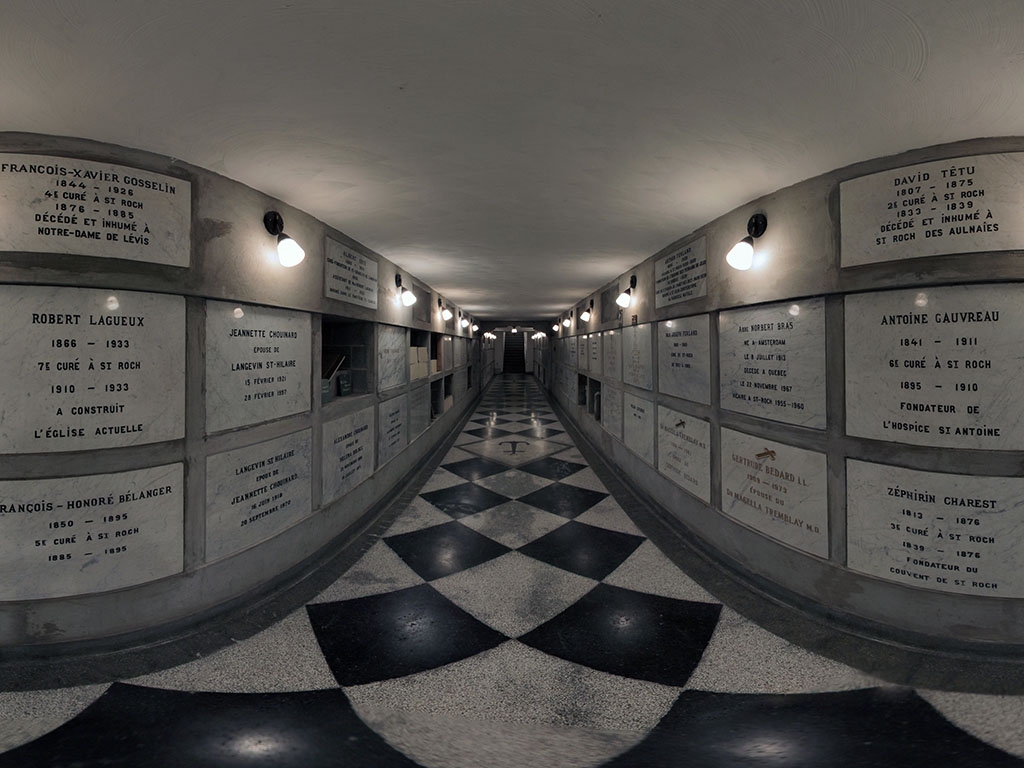A Sign of the Times
The current Saint-Roch Church was built in the early 20th century, back in the neighbourhood’s economic heyday. Just steps from the department stores on rue Saint-Joseph, the new place of worship stood out from the modern buildings around it with its architecture that harked back to the cathedrals of the Middle Ages. The church—the fourth to stand on the site since 1811—was part of ambitious plans to revitalize Saint-Roch.
Glorious again
For years Saint-Roch Church was masked by the roof that covered part of rue Saint-Joseph, turning the street into a mall. The dark, low stone wall visible from inside the mall gave little clue to the exceptional building on the outside.
The roof has since been removed, and the church is once again a neighbourhood landmark with deep community roots.
A man with a big heart
In the early 19th century, a number of poor working-class families moved to the burgeoning Saint-Roch neighbourhood, close to the shipyards springing up along Rivière Saint-Charles. In 1811 Monseigneur Joseph-Octave Plessis, the bishop of Québec, had a first chapel built where Saint-Roch Church stands today.
The bishop invested a lot of time in the neighbourhood. His body is buried in the city’s cathedral in Upper Town, but at his request his heart remains in the chapel in Saint-Roch.
Patron saint of the sick and poor
Lower Town was growing at such a clip that a new parish was needed, the first offspring of the mother parish Notre-Dame-de-Québec. The parish was named St. Roch in honour of the patron saint of the sick and the poor—a nod to the St. Roch hermitage that the Recollects had built by Rivière Saint-Charles in the 17th century—and the chapel became the parish church.
By 1841 it was already time to expand the first church. Thomas Baillairgé took the project in hand, but four years later a terrible fire destroyed it, along with almost all the surrounding neighbourhood. The parishioner who saved the reliquary containing Monseigneur Plessis’s heart from the blaze died of his burns days later.
The church was rebuilt straight away, bigger than ever. Charles Baillairgé, a second cousin to Thomas Baillairgé, redesigned the two towers on the 1841 façade, while Raphaël Giroux was the man behind the new interior.
The heyday of Saint-Roch
By the end of the 19th century, businessmen, industrialists, and professionals had set up shop in the area around the church. From its humble, working-class beginnings, Saint-Roch had become the city’s economic powerhouse, home to its factories and businesses.
Parish officials decided to build a church in keeping with the neighbourhood’s newfound status. They had to wait until the 1910s for their project to become a reality, when the architects Talbot and Dionne of Saint-Roch put forward plans for a church in a new, innovative style.
Construction began in 1914, but was soon slowed by World War I and the death of the architect, Talbot. The church was completed six years later, however, under Louis-Napoléon Audet, who was also responsible for the interior design.
The Middle Ages, revisited
The design by Talbot and Dionne was a blend of the two styles that had left their mark on the Middle Ages: the two monumental towers of the façade, each 45 metres in height, borrowed their semicircular arches from Roman style and their imposing verticality from Gothic style. The church’s huge rosette and other stained glass ornamentation were also Gothic in inspiration.
Inside the church, Audet, the architect, melded Roman and Gothic, but did away with the side galleries planned by the previous architects. This made the church’s interior particularly vast. Meanwhile local artists sculpted the liturgical furniture.
The heart of a neighbourhood
Today Saint-Roch Church has regained its place at the heart of the community. Masses are still celebrated there, its basement is home to a number of community groups—as well as a boutique showcasing the wares of Québec fashion designers—and the square in front is a popular meeting place. Artists project bold light shows onto its façade and, a sacred music festival is held there every year.
Related medias
Virtual tour

This is one of the last crypts still in use in Québec City. It includes the tombs of local priests and others who left their mark on the community.
Old pictures